


Busy supporting customers? Not anymore.
Watch hands-on webinar on workflows and easily automate your work in just five minutes!
A professional email is undoubtedly one of the online messages you’ll face as a business person. Since you’ve stopped by, I can guess that you already have hundreds of them to your credit. But do you always get the response you want from your recipients, such as customers or co-workers? If not, maybe it’s because your email wasn’t compelling or its structure wasn’t impactful enough.
This guide is to make your business email messages or subject lines effective enough to achieve your goals.
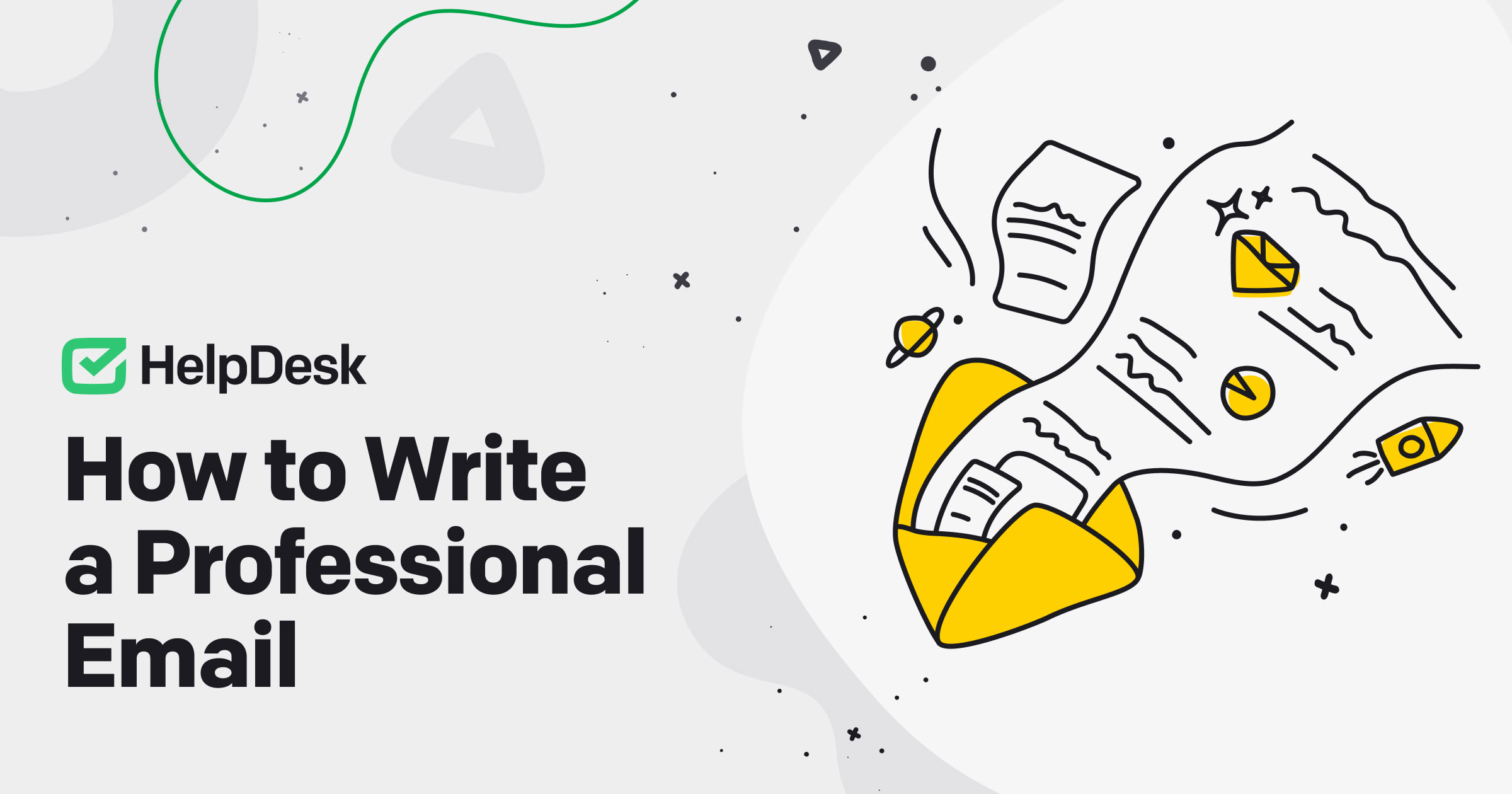
Before you get into the requirements for a professional email structure, make sure you’re sending the email to the right group of recipients. Instead of manually creating the list, you can buy targeted email list from a reputable provider.
Once you’re sure you’ve got correct emails on your list, start writing. The good news is that some of these rules may be familiar to you, so you’ll be able to quickly refresh your knowledge and then jump into action to deliver emails professionally.
Bombarding your recipient with too much information at once can make them feel overwhelmed. Try not to cover too many topics at once. It’s best to set one clear goal for your professional email.
Before writing the draft of your message, complete this line: “I’m writing this email to [your goal].” Define your purpose, which you can refer to whenever you create a new sentence in your email. If a sentence doesn’t stick to your main goal, cut it out — this will keep your message short, coherent, easy to understand, and actionable. Once you’ve tackled your email, make sure that everything you included in it supports your main purpose.
Don’t make your recipient think too much over your message — keep your email clear in terms of structure. A standard email structure consists of:
A proper greeting
A pleasantry and welcome statement
The main purpose of the email
Details and further information
A call to action and a closing statement
A fitting sign off and your signature
Stick to these formal email elements to keep your message consistent and succinct.
Also, try out the “five-sentence rule” for your business communication. This rule involves keeping messages to a maximum of five sentences in length. This technique increases the chance of a quicker response from the recipient. Professional emails that are shorter than five sentences can make you seem snappy or rude. Overly long messages run the risk of losing the recipient’s attention.
Pay attention to your word choice and, consequently, the tone and voice of your message. Be mindful of your language depending on the recipient, as you don’t want to be misinterpreted. Your formal email should:
Contain positive and uplifting words but not overly emotional.
Feature casual or formal language depending on the situation.
Be respectful and pleasant. Don’t use your authority to impose a quicker response.
Be personable but not pushy or needy.
Be grammatically checked and fit the organizational culture.
Use transitional phrases to move gracefully to the next point in the message. Also, embrace congenial words, so you won’t be seen as a person with a demanding attitude.
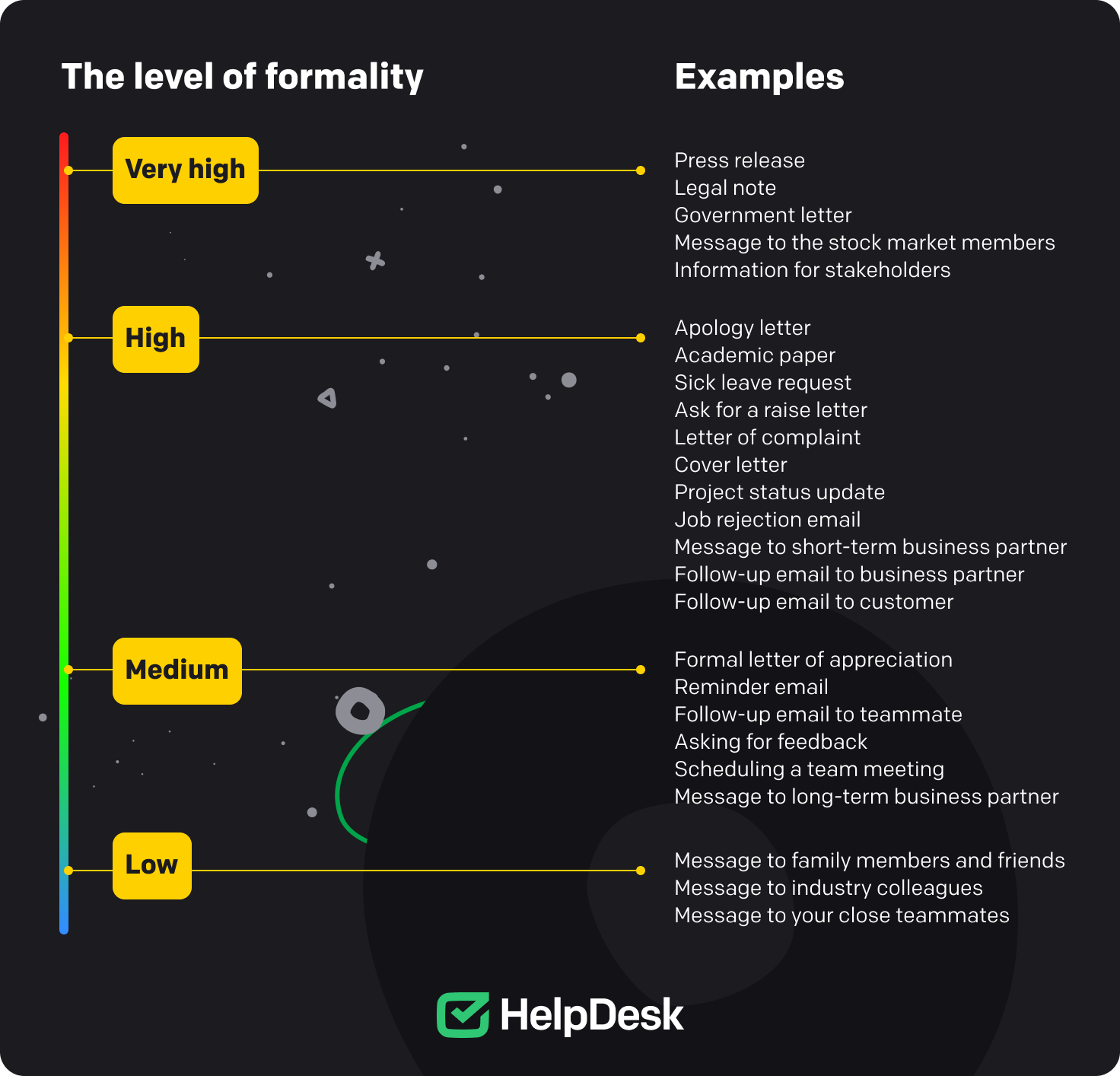
There’s a good chance that your recipient will screen your email and close it. We’re living in a modern society, where everything is getting faster and faster, and people are overloaded with news. Knowing this, include key information at the beginning of your formal email message. Just assume that your recipient is busy and make your email effortless — thank them for their attention and politely get straight to the point.
Find a quiet place where you can read your business email aloud. This is the best way recommended by copywriters to make sure your message is kept in a conversational style.
You can find many tips and tricks online on how to write a professional email, but the practical knowledge is quite scattered. That’s why I’ve done the legwork and compiled 12 rules you can easily follow in one spot.
Right now, open the message creation box with your saved email draft and see if your message meets all the requirements.
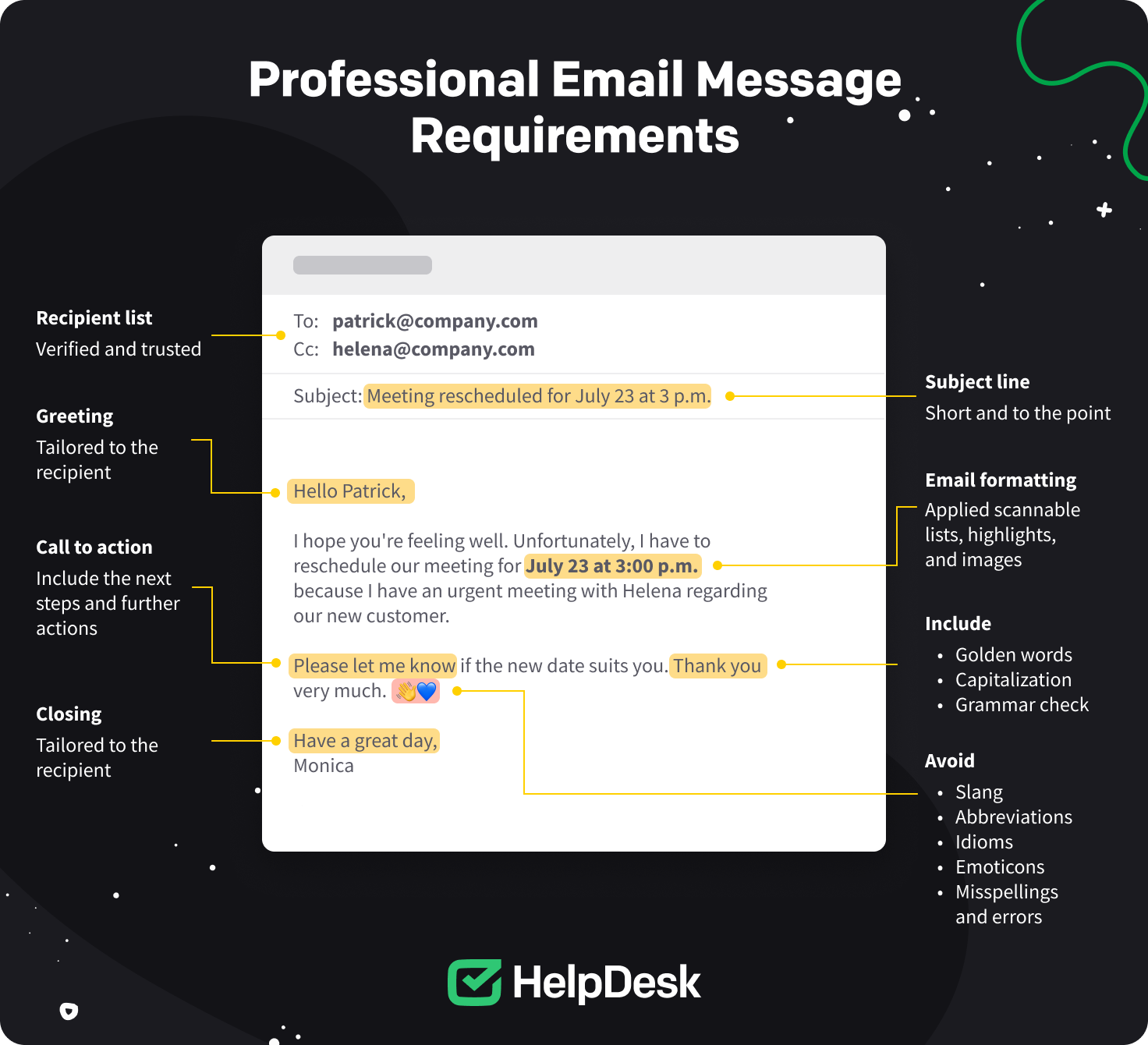
Consider the audience of your professional email and ensure you include all the people that should stay in the loop. Take extra care for writing the email addresses in the “To,” “Cc,” and “Bcc” email fields. Also, your choice of recipients will determine your tone of voice in the email.
If you put an email address in the “To” field, it indicates that you expect a response from the recipient and action on their part, since the message relates directly to them. You can also include all the names from the “To” field in the greeting (up to three names, for example, Dear Elton, Clarissa, and Annie) to engage them even more. If you’ve added more than four names in the “To” field, use “Dear All,” “Hello Team,” or simply “Hello Everyone.”
If you put an email address in the “Cc” field, it’s a sign that you want to keep the recipient in the loop without pressuring them to respond or take action. You can use the “Cc” field to pass on updates to your high-level employees, stakeholders, board members, or business partners.
If you put an email address in the “Bcc” field, you can send an email message to a group of email addresses without letting the recipients know who else received the same message. The complete list of recipients is secure and visible only to you as the sender.
According to the data, the average person receives more than 100 emails a day. If this is the case for you, honestly consider which emails you read in the first place. Sure, there will be messages from your boss, a sales director, a project colleague, a support supervisor, an admin, or an important customer, but there are still a bunch of messages queued up.
I bet you start with emails with a catchy and meaningful subject line. For this reason, make sure your subject lines are driven by these values to increase your open rate.
First, use fewer than ten words when writing your subject line to ensure it’s easy to wade through yet descriptive and informative. The subject line should summarize why you’re contacting recipients and describe the topic or nature of your message.
When the inbox is overflowing, the subject line can determine whether the recipient will open and read your message or move it straight to the trash or spam folder. A smart email subject line is your chance to grab the attention you need.
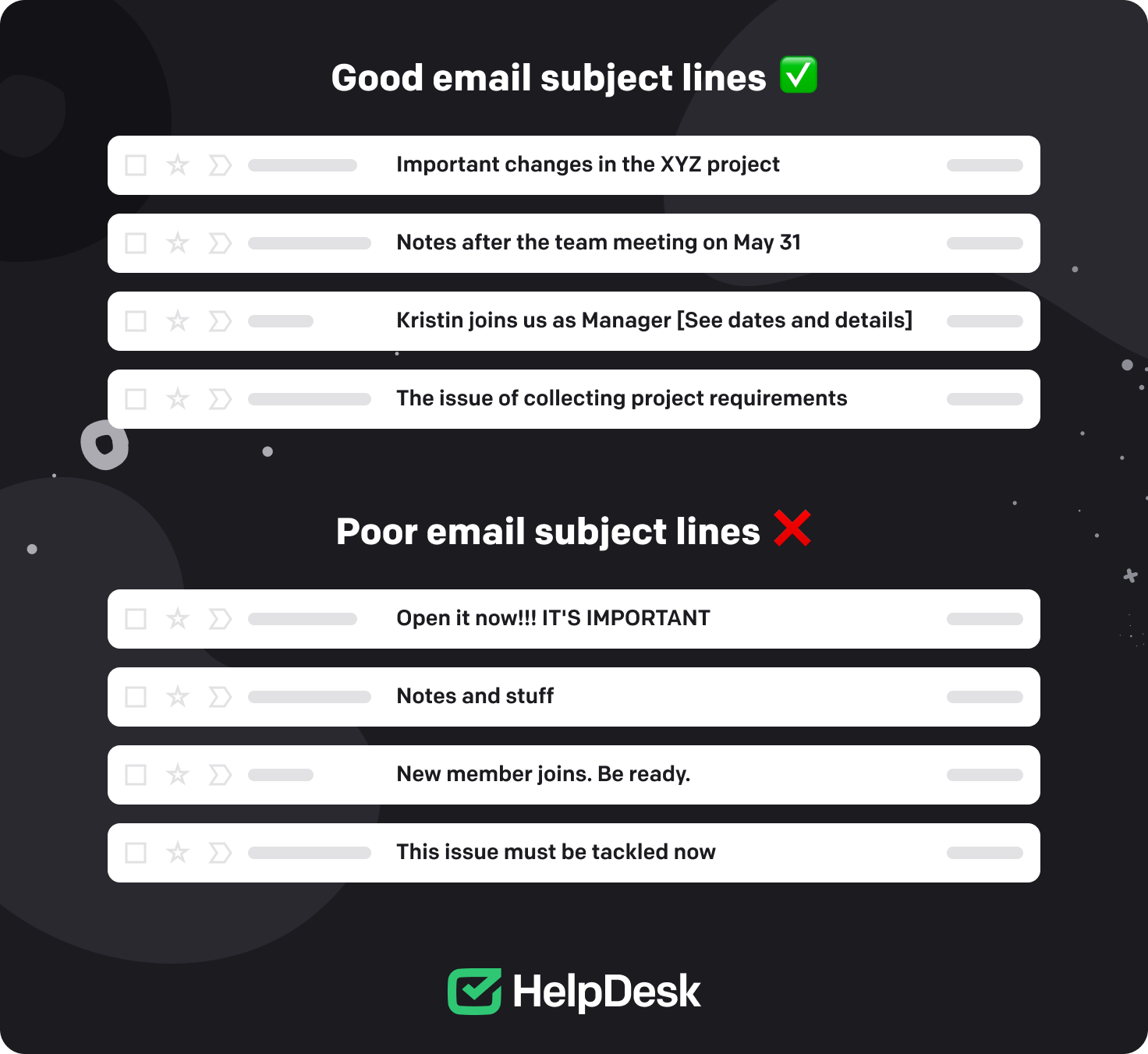
How should you start a professional email? Often it’ll simply be “Hello,” but on the other hand, “Dear Sir” will work better in some situations. Boost the positive impact of your email by greeting adequately and using proper etiquette. This is the initial element of showing respect and rapport. When in doubt, you can always check out the list with the best email greetings for any occasion.

A well-composed email message is friendly, clear, concise, on point, and actionable. What’s more, all these qualities apply to every part of an email’s content. Keeping the hierarchy of information in mind, let’s see what the introduction, body, and conclusion components look like when writing emails.
This is the space for a welcome and opening sentence, in which you should state the reason for your email. You can do so with this sentence:
I’m writing to inquire about…
I’m writing to let you know about…
I’m writing to ask about…
I’m writing in reference to…
I’m writing regarding…
Then you can smoothly move on to the next part of your message, the email body.
The body of the email is the meatiest and most crucial part, where you need to provide more details — bottom line: the less, the better. Keep the body of your email short, preferably five sentences at most. Include all relevant information, helpful contacts, asks, and further requirements. Add the necessary dates and deadlines that would be important for moving the matter forward. Attach essential documents, files, or other email attachments.
Also, remove filler words and unnecessary specifics to make your email more succinct. If you find that you have added a reference to another project or topic, which is also something you need to announce, compose another email. Simple as that!
After giving the reason for writing the email and articulating all the details and key dates, now is the time to wrap up the message with further steps.
Convey a clear request to your email audience. If there’s something they need to know, the conclusion section is the best place to tell them — it plays a huge role in helping your recipient formulate a response or ask follow-up questions.
If necessary, you can refer in your email to what you discussed with the recipient in the past. Just quote a paragraph from the previous message or even attach an old conversation and add the date and time of the source email. This way, you can be on the same page while remaining in the current email chain.
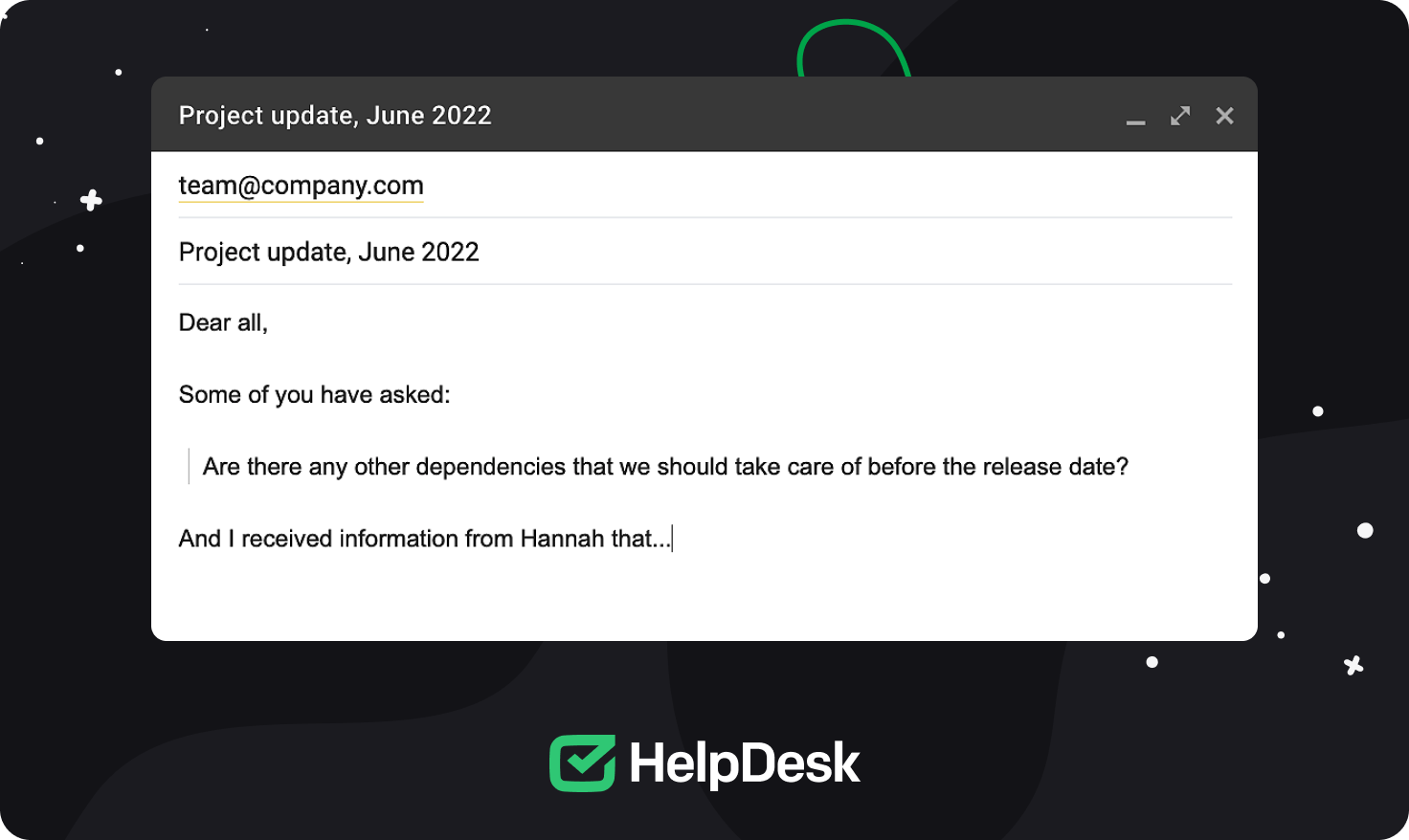
Break up your message to make it easier to read. For one thing, the “Enter” button is your friend — don’t be afraid to use it to create a pause or move to another paragraph. Underline one word or phrase in each paragraph, using the “Bold” feature to identify the main idea. Use bulleted or numbered lists to arrange your text and make it reader-friendly. Add images and screenshots that support your content and incorporate them to make it more appealing.
You can check out what else your email provider has to offer when it comes to formatting in the email creation box. Test them for greater effect.

Don’t use slang, abbreviations, or hard-to-understand idioms, as there’s a fair chance your recipient won’t understand them and will get frustrated. Develop abbreviations and employ commonly used words to explain concepts in a simple and accessible way. Also, avoid emoticons, as they can infantilize your message and make the recipient not take it seriously.
As a child, you probably heard about the golden or magic words, namely “Thank You,” “Sorry,” “Excuse Me,” “May I,” and “Please.” This is the basis of all communication, including online.
Sticking to proper email etiquette is especially important for one-on-one correspondence. Use these golden words often to appreciate or direct the recipient to do something in a reasonable way.
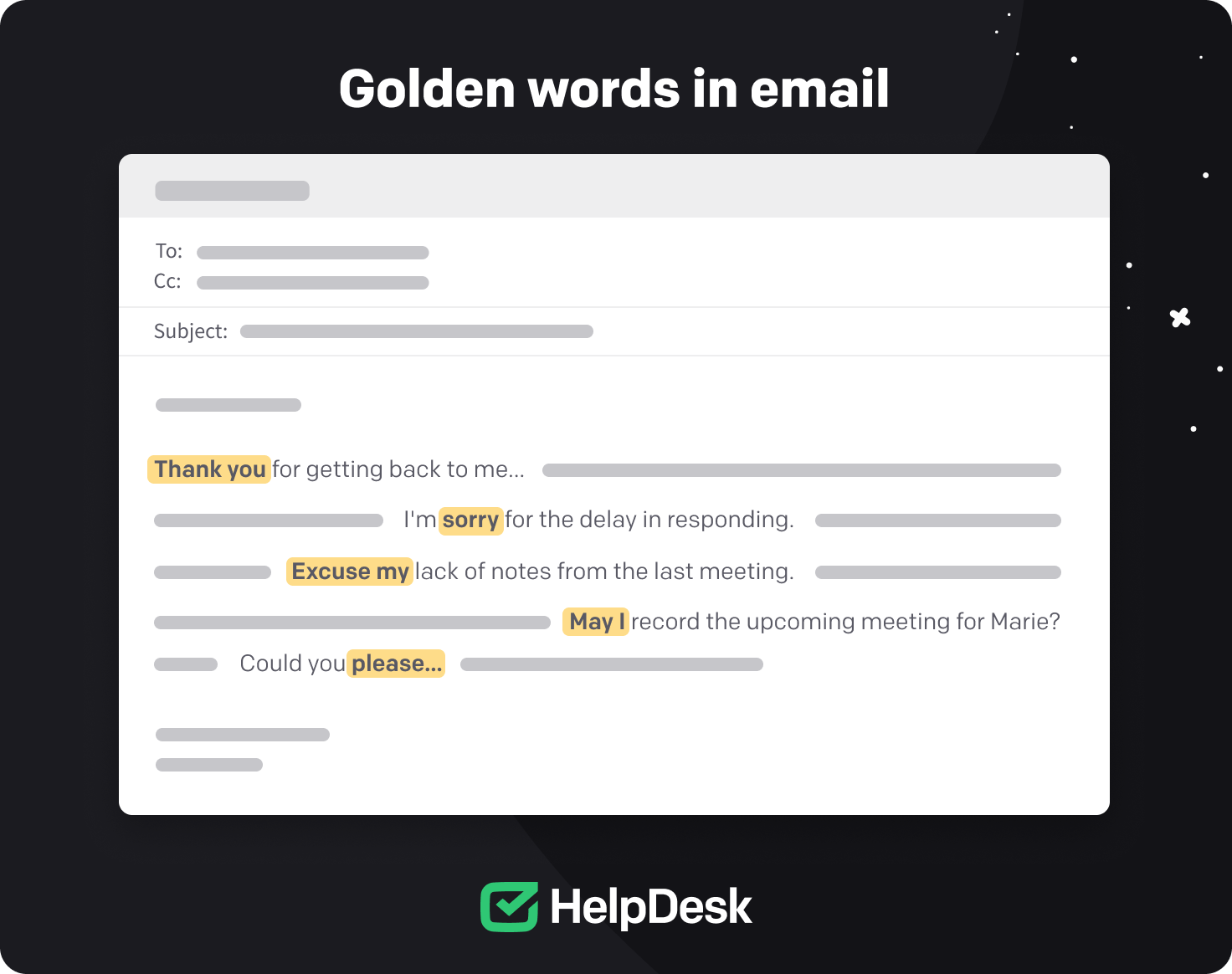
Wrap up what you need from your recipient as a call to action (CTA). This element is designed to clearly outline the next steps and actions your recipient should take. The CTA should be worded as follows:
Could you please write the requirements in the next three weeks?
Could you please send me notes by Wednesday?
Could you please contact Maddie about this client and add me to the “Cc” field?
Note that structuring your request as a question will make the recipient feel obligated to respond more quickly. Also, suggest a time frame in which you’d like your recipient to act and follow up with you. Place the CTA near the closing line of the email, as this is where our gaze is focused.
Let’s move on to the closing part for your email based on your preferences and circumstances. Do you know how to close a professional email? Luckily, you can browse a ready-made list with the best email closings and sign-offs depending on the situation, or just go with a safe “Best regards” or “Thank you.”
Once you’ve chosen your formal email closing, add an appropriate signature to tell the recipient who you are without having to introduce yourself multiple times. In your email signature, you can include your name, company/organization name, job title or position, professional image, pronouns, email address, and phone number. You can use these ingredients to create a perfect professional email signature.
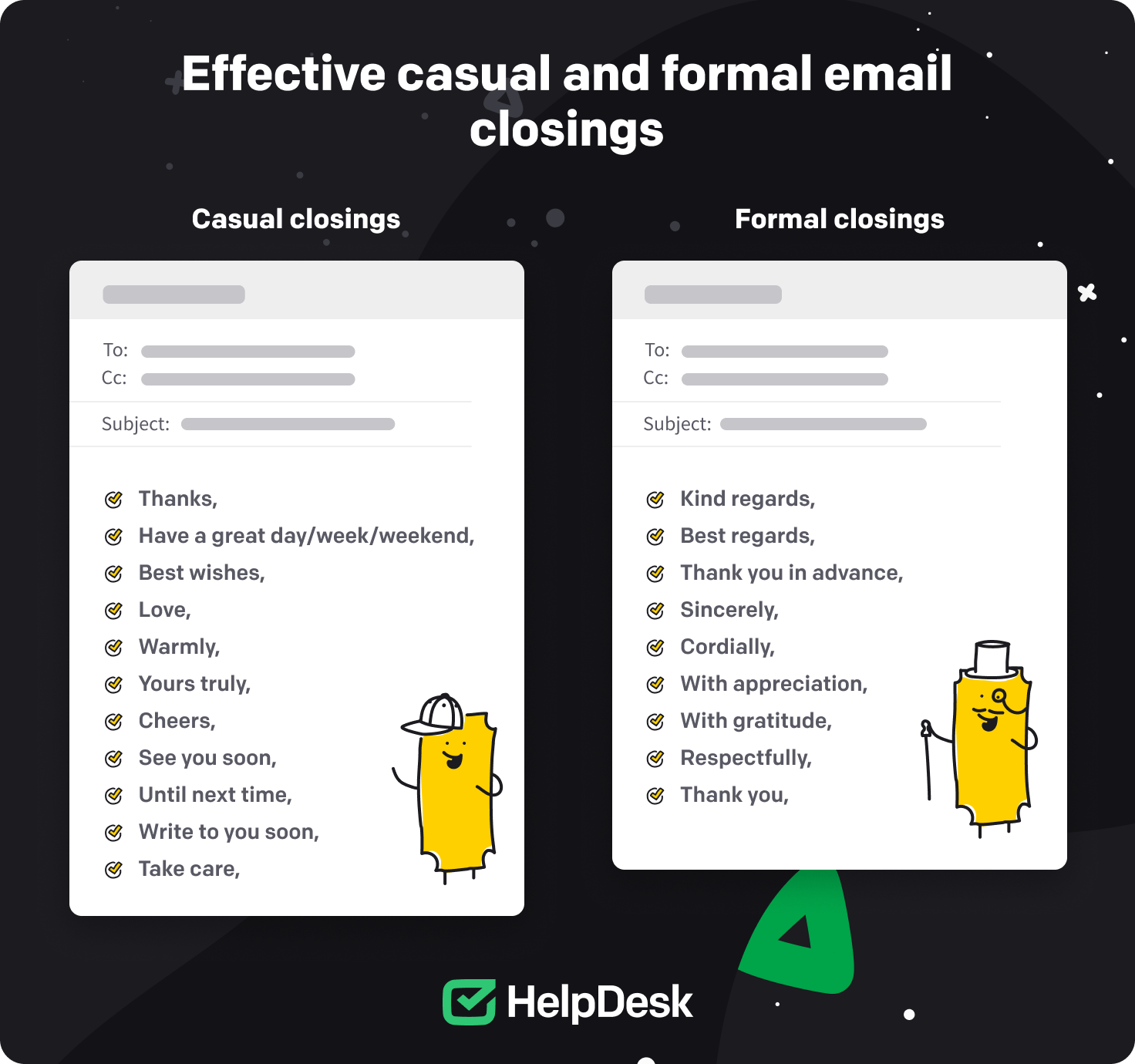
An error-free email points to your commitment and the care you put into composing your message. For this reason, before you send your email, take a moment to thoroughly proofread it and look for any spelling, grammar, or syntax mistakes. Read about email typos and other traps you should avoid when doing a spell check.
Also, ensure that you’ve included any email attachments you may have alluded to in your professional message. Confirm that your closing remarks and CTA are straightforward. If you’re sending your email to a critical customer, you may also want to ask an office teammate to double-check your draft, as two heads are better than one.
Remember to schedule a follow-up message with your recipient if they haven’t responded within 48 hours or two/three business days. Simply clicking the “Reply” button will put the next message in the same message chain. Such a friendly follow-up email is a key step in the email communication process and shows your dedication to the cause.
If you notice something in the email that you’d like to change as you’re sending it, you can try to undo or unsend your email message. Be fast, though, because you may only have a few seconds to recall it and update it to the version you want!
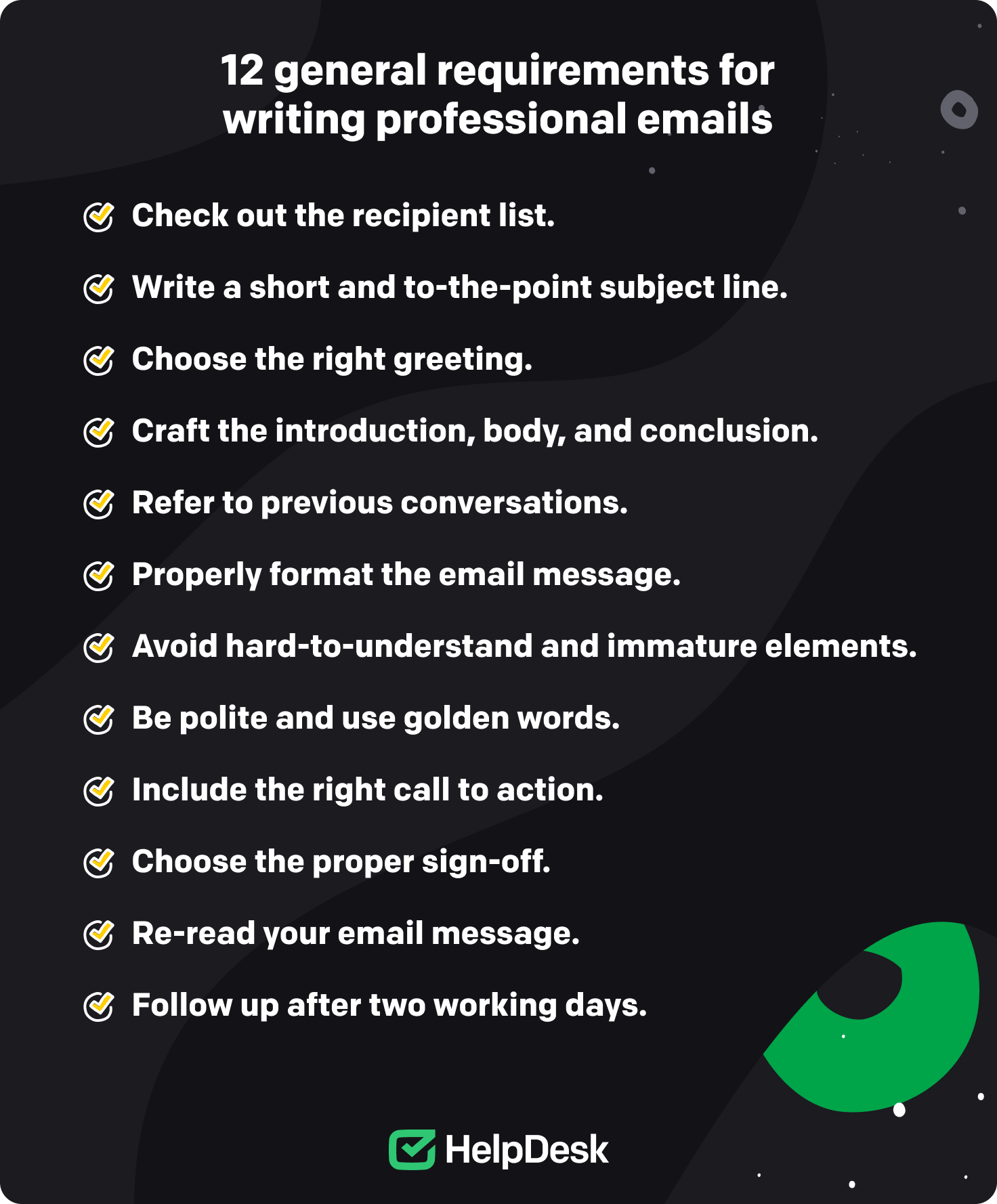
There may be many occasions when you need to send a professional email, such as a follow-up email, a feedback email, an invitation to an event, a cover letter to a potential employer, a resignation letter to your current boss, or an apology email to a customer. Expert email writing takes time, and there are usually many mistakes along the way, but you don’t have to learn it the hard way.
Let’s go through general and professional email examples you can easily adapt to your situation, such as feedback, follow-up, and invitation emails.
The first formal email that you definitely need to know how to write is a feedback request email. You can ask your friend, teammate, customer, or business partner for their opinion by email. Follow the examples below to get a better understanding of how to do this.
Subject line: Help me become a better expert Hi [teammate name], I hope you're doing well. I'm writing to ask for your feedback on my work so far. I've been in the marketer position for six months and would like to hear how you view me as a team member. Would you please take five minutes and fill out this feedback form for me? [link to the form] Please be honest in your answers. If you didn't like something about my work, don't be afraid to point it out. The same goes for the good aspects — if I should continue to do something, please let me know. I take your feedback very seriously and am ready to make changes to be a better specialist. Thank you so much, [Your signature]
Subject line: We need your honest feedback Hello [customer name], We greatly appreciate you using our product since [date]. We'd like to carry on doing a great job, but we can't do it without your honest feedback. Would you please take 2 minutes to complete a short survey about your experience? [link to form] This survey will help us improve our products to exceed your expectations. Thank you in advance for your time and effort. With appreciation, [Your signature]
Afraid to write a follow-up email after no response? Not anymore. Let’s make your follow-up a warm and polite message that no one will be able to resist, causing them to hit the “Reply” button. Also, when scheduling the mailing, take into account the recipient’s time zone.
Subject Line: Following up on our discovery meeting Hello [recipient's name], Thank you for joining the meeting last Thursday — it was a great pleasure to meet you and learn about your business needs. I've sent you some notes from the meeting and attached a dedicated development plan just for your business case. I'd love to hear your feedback on it. We can also review it together to make sure everything is crystal clear. What would you say to a short meeting this Wednesday? Thank you, [Your signature]
Subject: RE: [subject line of your previous email] Hi [recipient's name], I decided to follow up on my previous email about a potential collaboration between our companies. I'm still very open to this possibility, and I secretly hope you are too. It's understandable that such decisions take some time, but if there's anything I can do to give you support, please let me know. I look forward to hearing from you. Best regards, [Your signature]
You can easily arrange meetings through email communications, and this part is about writing a formal email with an invitation.
Subject: Invitation to a board meeting on October 11-16 Dear Mr. Collins, I'd like to invite you to a board meeting on the further development of the XYZ product on October 11-16. Your opinion as a stakeholder is very important to us, and we'll be happy to consider it when choosing directions for our product evolution. I'll do my best to provide you with all the necessary documents before the meeting so that you're well-informed. Please let me know if we can count on your attendance. Sincerely, [Your signature]
Subject: Meeting invitation [dates and schedule inside] Hello [recipient's name], Please join me for a meeting on [date] at [time] to discuss [topic]. The purpose of this meeting is to [goal]. Take a look at the meeting schedule for more information: Topic #1 (approximate time of discussion) Topic #2 (approximate time of discussion) Topic #3 (approximate time of discussion) Topic #4 (approximate time of discussion) Please bring a computer to work comfortably with the virtual matrix during the meeting. If you have any questions or comments about the schedule, please let me know. Thank you, [Your signature]
Learning how to write business emails is a critical skill for advancing your career. Use the above tips and email template examples to compose effective email messages in no time.
Join the in-depth “Business Email Writing” course to learn more about effective email communication methods and become a professional writer.
Weronika Masternak
Weronika is a product content designer at HelpDesk. She has a deep passion for telling stories to educate and engage her audience. In her free time, she goes mountain hiking, practices yoga, and reads books related to guerrilla marketing, branding, and sociology.
Try HelpDesk for free
For quick and intuitive tickets management